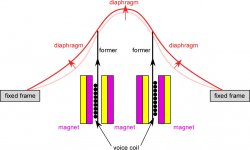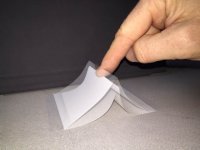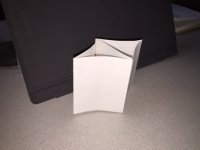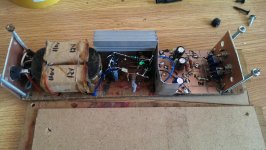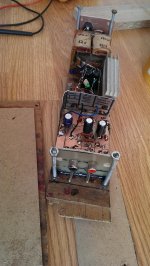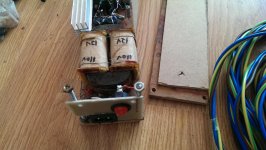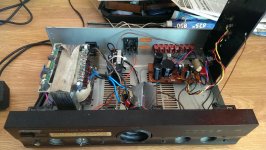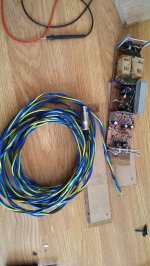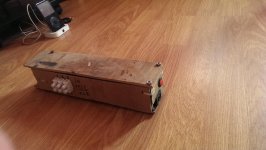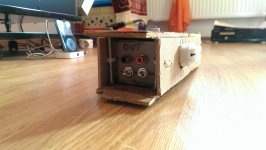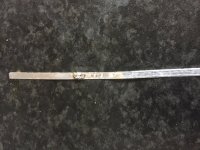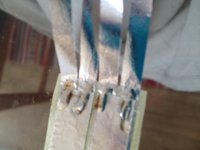🙂 nice some good f eedback on your vid. we might try to do this more often. the more easy it goes and i think it is very nice. im bussy with another project but when i go into the ruba domain ill try to make some more vids as well 🙂 i liked it
I don't want to distract anyone from the excellent work described in this thread, but the discussions of geometry reminded me of Roy Allison's midranges and tweeters in the 1970s and 1980s. A casual glance at those drivers suggested they were just conventional domes but they were rigidly fixed at the outer edges. There was no flexible surround. As a result, the diaphragm's motion approximated a pulsating hemisphere.
I wonder if a linear version of his geometry might be interesting. The result would be (approximately) a pulsating cylinder. I'm attaching a sketch that can be interpreted two ways. 1) A cross section through Allison's dome-like driver, or 2) a cross section through a cylindrical analog---a modified Rubanoide. The central "dome" portion could be made as narrow as one wishes, even to the point of eliminating it and having a single driving point, like a Rubanoide.
I've not tried this idea so it might be fatally flawed. On the other hand maybe it opens up possibilities that address Rubanoide issues (although this thread suggests the more familiar Rubanoide design has lots of potential).
If this feels like a thread-hijack I can move it elsewhere. I posted it here because the Rubanoide discussion brought it to mind.
Few
Few
I wonder if a linear version of his geometry might be interesting. The result would be (approximately) a pulsating cylinder. I'm attaching a sketch that can be interpreted two ways. 1) A cross section through Allison's dome-like driver, or 2) a cross section through a cylindrical analog---a modified Rubanoide. The central "dome" portion could be made as narrow as one wishes, even to the point of eliminating it and having a single driving point, like a Rubanoide.
I've not tried this idea so it might be fatally flawed. On the other hand maybe it opens up possibilities that address Rubanoide issues (although this thread suggests the more familiar Rubanoide design has lots of potential).
If this feels like a thread-hijack I can move it elsewhere. I posted it here because the Rubanoide discussion brought it to mind.
Few
Few
Attachments
One clarification:
My sketch duplicates Allison's design but a dipole version, similar to the Rubanoide, seems even more interesting. If ideal pulsating half-cylinder behavior could be achieved both front and back, but out of phase, then an excellent approximation of a perfect dipole would result. That would yield directivity independent of frequency.
There's no doubt the reality of the performance of real materials would complicate things...
Few
P.S. I just discovered Roy Allison died just three weeks ago at age 88, and about two hours from where I live. Strange coincidence.
My sketch duplicates Allison's design but a dipole version, similar to the Rubanoide, seems even more interesting. If ideal pulsating half-cylinder behavior could be achieved both front and back, but out of phase, then an excellent approximation of a perfect dipole would result. That would yield directivity independent of frequency.
There's no doubt the reality of the performance of real materials would complicate things...
Few
P.S. I just discovered Roy Allison died just three weeks ago at age 88, and about two hours from where I live. Strange coincidence.
Last edited:
Hi Few,
You are not highjacking this thread. You'ed just come with a new ideea. This ideea was allready tested by a colleague of ours in this thread but he quited his project and tried this type of loudspeaker (ruban) and as we can see here other colleagues have tooked your concept in another direction HERE.
I dont say that your concept isnt good. It looks very exotic and seems that Mr Roy was a very well informed and talented person. We could apply this concept here but the problem is the material used in the membrane.. Our coil (with laqueur and former) is bigger and heavier and harder to keep in the gap.. Another aspect is that i dont know how we shoud modify this simple elastics/hinges ruban sistem to sustain Mr Roy system at this scale because our "8" transducer shape with cilinders will transform into an "thick book opened in the middle" shape (you know what i mean).
Its not impossible to do and in the future after i finish the ruban and bass enclosures i will try this concept at a smaller skale to see how it works.
"P.S. I just discovered Roy Allison died just three weeks ago at age 88, and about two hours from where I live. Strange coincidence."
Yes it is very strange. Have you tried to contact his friends, maybe he has some notes about his concept home willing to share them ...
I think that its not good to dedicate you own whole life in the audio field and at the end not share you discoveries with others because all your work will remain in vane, wasted. I'm sorry for Mr Roy.
I took a look at your link and i found there where some very interesting ideeas in "the speaker and the listener" and "wich is more acurate". As the ruban radiates sounds in both ways this issue (the speaker and the listener") begins to be very important as we will listen in a normal room with or without damping.
Cheers
Sergiu
You are not highjacking this thread. You'ed just come with a new ideea. This ideea was allready tested by a colleague of ours in this thread but he quited his project and tried this type of loudspeaker (ruban) and as we can see here other colleagues have tooked your concept in another direction HERE.
I dont say that your concept isnt good. It looks very exotic and seems that Mr Roy was a very well informed and talented person. We could apply this concept here but the problem is the material used in the membrane.. Our coil (with laqueur and former) is bigger and heavier and harder to keep in the gap.. Another aspect is that i dont know how we shoud modify this simple elastics/hinges ruban sistem to sustain Mr Roy system at this scale because our "8" transducer shape with cilinders will transform into an "thick book opened in the middle" shape (you know what i mean).
Its not impossible to do and in the future after i finish the ruban and bass enclosures i will try this concept at a smaller skale to see how it works.
"P.S. I just discovered Roy Allison died just three weeks ago at age 88, and about two hours from where I live. Strange coincidence."
Yes it is very strange. Have you tried to contact his friends, maybe he has some notes about his concept home willing to share them ...
I think that its not good to dedicate you own whole life in the audio field and at the end not share you discoveries with others because all your work will remain in vane, wasted. I'm sorry for Mr Roy.
I took a look at your link and i found there where some very interesting ideeas in "the speaker and the listener" and "wich is more acurate". As the ruban radiates sounds in both ways this issue (the speaker and the listener") begins to be very important as we will listen in a normal room with or without damping.
Cheers
Sergiu
Ah yes, I remember following that remarkable thread about the MBL replicas. Impressive work.
It's quite different from what I was envisioning, though. Your book analogy is closer to what I had in mind. In dipole form, and without Allison's central dome component, it might look like the very sophisticated mock-up in the second photo I'm attaching. The four curved surfaces would be the diaphragms and the central planar surface would hold the voice coil. In a sense it's a Rubanoide with the concavity of the diaphragms reversed. The first photo tries to convey the motion of one of the two diaphragms.
It took all my CNC and 3D printing skills to make these mock-ups so I hope it's clear what they're supposed to represent.🙂
It's quite different from what I was envisioning, though. Your book analogy is closer to what I had in mind. In dipole form, and without Allison's central dome component, it might look like the very sophisticated mock-up in the second photo I'm attaching. The four curved surfaces would be the diaphragms and the central planar surface would hold the voice coil. In a sense it's a Rubanoide with the concavity of the diaphragms reversed. The first photo tries to convey the motion of one of the two diaphragms.
It took all my CNC and 3D printing skills to make these mock-ups so I hope it's clear what they're supposed to represent.🙂
Attachments
Ah yes, I remember following that remarkable thread about the MBL replicas. Impressive work.
It's quite different from what I was envisioning, though. Your book analogy is closer to what I had in mind. In dipole form, and without Allison's central dome component, it might look like the very sophisticated mock-up in the second photo I'm attaching. The four curved surfaces would be the diaphragms and the central planar surface would hold the voice coil. In a sense it's a Rubanoide with the concavity of the diaphragms reversed. The first photo tries to convey the motion of one of the two diaphragms.
It took all my CNC and 3D printing skills to make these mock-ups so I hope it's clear what they're supposed to represent.🙂
Hi Few,
I think that this will be very interesting to test in the future at a smaller scale..
Cheers
Sergiu
Hello Wrine,
I will bolt this ideea with blue color because for me it is a very important and one of my final choices for the final version of ruban.
Yesterday i tested the ruban even more, especially in the laqueur adenum chapter as we have talked in the earlier posts, and my conclusions are:
-adding laqueur to 25-30% of the surface of each cilinder really improves the high frecvency response and i perceive it like some dB's are aded as well;
-adding more than 30% laqueur to each cilinder somehow ads some more mids in a way that they seem to shout. Its like some nasty resonances appear wich i perceived very clear.
I dont know if my phone records well, but i want to tell you for shure that this second point (more than 30% laqueur) is perceived even more when you crank up the volume. These are my recorded vids with this adenum:
1)https://www.youtube.com/watch?v=gZaVTrgSyTM
2)https://www.youtube.com/watch?v=GzF3lRvwnV4
Cheers
Sergiu
I will bolt this ideea with blue color because for me it is a very important and one of my final choices for the final version of ruban.
Yesterday i tested the ruban even more, especially in the laqueur adenum chapter as we have talked in the earlier posts, and my conclusions are:
-adding laqueur to 25-30% of the surface of each cilinder really improves the high frecvency response and i perceive it like some dB's are aded as well;
-adding more than 30% laqueur to each cilinder somehow ads some more mids in a way that they seem to shout. Its like some nasty resonances appear wich i perceived very clear.
I dont know if my phone records well, but i want to tell you for shure that this second point (more than 30% laqueur) is perceived even more when you crank up the volume. These are my recorded vids with this adenum:
1)https://www.youtube.com/watch?v=gZaVTrgSyTM
2)https://www.youtube.com/watch?v=GzF3lRvwnV4
Cheers
Sergiu
Hello Wrine,
I will bolt this ideea with blue color because for me it is a very important and one of my final choices for the final version of ruban.
Yesterday i tested the ruban even more, especially in the laqueur adenum chapter as we have talked in the earlier posts, and my conclusions are:
-adding laqueur to 25-30% of the surface of each cilinder really improves the high frecvency response and i perceive it like some dB's are aded as well;
-adding more than 30% laqueur to each cilinder somehow ads some more mids in a way that they seem to shout. Its like some nasty resonances appear wich i perceived very clear.
I dont know if my phone records well, but i want to tell you for shure that this second point (more than 30% laqueur) is perceived even more when you crank up the volume. These are my recorded vids with this adenum:
1)https://www.youtube.com/watch?v=gZaVTrgSyTM
2)https://www.youtube.com/watch?v=GzF3lRvwnV4
Cheers
Sergiu
different people same idea;s 🙂 i just laquer at exact same spots on the front , i as well used 25-30% and layed it down horizontal , else it will walk down instead of into the coil 🙂
one thing when you got you mic running, please notice that in the exact center the high end 15khz to 20khz will have a dip move side ways and it will increases in output, then it drops again. when a analyzer is used you can move the mic from left to right and you will see this in the response.
you are right i can hear on the drums the backside is to bright compared to the other side
GJ on the vid again! thx
Thanks Wrine,
Tomorrow i will work at the amp and phantom psu. I know that you allready tested this stuff out. I wanted to write here also.
I cant whait to measure with the mic.
Cheers
Sergiu
Tomorrow i will work at the amp and phantom psu. I know that you allready tested this stuff out. I wanted to write here also.
I cant whait to measure with the mic.
Cheers
Sergiu
Hello again my friends,
I got some work in progress but not at the ruban. I made a phantom psu for the mic (for ruban measures), a jlh 69 amp for ruban testing wich sounds very good, a xlr to rca adapter from the phantom psu and cables and all the 7 m wires and housings..
I still have to make a mic support and test the new output transistors wich just arrived for my burned output channel in my Hiraga amp and hope next week begin rubanoide jurney again.
I got some work in progress but not at the ruban. I made a phantom psu for the mic (for ruban measures), a jlh 69 amp for ruban testing wich sounds very good, a xlr to rca adapter from the phantom psu and cables and all the 7 m wires and housings..
I still have to make a mic support and test the new output transistors wich just arrived for my burned output channel in my Hiraga amp and hope next week begin rubanoide jurney again.
Attachments
Good job ! he sergiu !! i bought these flux
Flux Used for Soldering of Aluminum Stainless Steel Nickel Copper | eBay
to solder aluminium , only 3 dollar. and it works great i tested it on some alumnium foil works, i just used some ordinairy electronics solder and it was stuck right away!!! i am very very pleased and impressed. (for once stuff does what it says it does 🙂)
Flux Used for Soldering of Aluminum Stainless Steel Nickel Copper | eBay
to solder aluminium , only 3 dollar. and it works great i tested it on some alumnium foil works, i just used some ordinairy electronics solder and it was stuck right away!!! i am very very pleased and impressed. (for once stuff does what it says it does 🙂)
Good job ! he sergiu !! i bought these flux
Flux Used for Soldering of Aluminum Stainless Steel Nickel Copper | eBay
to solder aluminium , only 3 dollar. and it works great i tested it on some alumnium foil works, i just used some ordinairy electronics solder and it was stuck right away!!! i am very very pleased and impressed. (for once stuff does what it says it does 🙂)
Hi Wrine,
That product looked really really good and the seller is romanian. Now my question for you is: have you tryied to solder to 2mm track? That is the real test and a colleague of ours pointed out this aspect here.
My flux solders very well to a bigg Al surface, but on 2 mm trace is mich harder to solder on.
If its good please report back because i want to buy that stuff too.
Cheers
Sergiu
well on a 3mm piece it works, i dont see any problems for a 2 mm
i might need to buy some more bottles, before he runs out. since he already sold 450 bottles
first flux ive seen that works for al, it might not be the best looking solder job but it is stuck 🙂 and it does flow
i might need to buy some more bottles, before he runs out. since he already sold 450 bottles
first flux ive seen that works for al, it might not be the best looking solder job but it is stuck 🙂 and it does flow
Attachments
Last edited:
Thanks, great tip, ordered two. Do you have anything worthwhile to listen to? Still curious, even if not perfect, as long as it makes recognizable sound.
Thanks, great tip, ordered two. Do you have anything worthwhile to listen to? Still curious, even if not perfect, as long as it makes recognizable sound.
well i put my ruba asside to be honest(for now , and i got no working type atm used the magnets for something else) 🙂 exploring the depths of AMT alike. 🙂 and i mean broadband amt 🙂 aiming for 500hz and
up. looking to se if it is plausible to make a line source out of them with low power magnets(cheaper neo's then most people use) to compensate for costs, and still yield a healthy efficiency.
ill send you a PM when i got one of the rubba's up.
Last edited:
- Home
- Loudspeakers
- Planars & Exotics
- A DIY Ribbon Speaker of a different Kind
